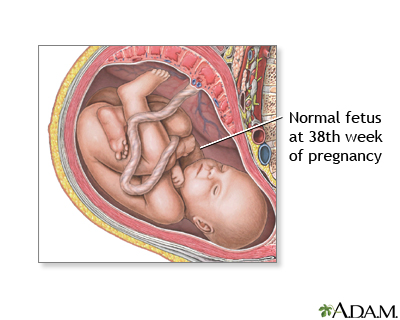- Welcome to Week 38
 ##RemoveMe##
##RemoveMe##
- Your Baby: Reaching Full-term
During the last couple weeks of pregnancy, your baby might gain a very small amount of weight. Or they may stop gaining at all. Now considered full-term, your little one may weigh anywhere from 6 to 9 pounds (2.7 to 4 kg) and measures about 21 inches (53 cm) long.
##RemoveMe##
- Your Body: Getting Into Position
There is no right or wrong, best or worst position to give birth. It depends on what is comfortable and what is happening. Most women do well lying on their side during labor. Others may feel better walking around, taking a shower, or pacing the hospital's hallways. Listen to your body to find the position that works best for you and helps labor progress. Always remember that whatever position you're in there are options:
- On Your Side. Takes pressure off your perineum and keeps the weight of your uterus off the blood vessel called the inferior vena cava. This maximizes blood flow to your uterus and your baby. Have your partner hold your upper leg to widen the pelvic outlet and support the weight of the baby.
- Flat on your back. This position is generally less comfortable. It can cause your uterus to press against the inferior vena cava blood vessel, decreasing the placenta blood supply. Your uterus may also push against your diaphragm, making it hard to breathe. A more comfortable position is more upright. Sit in a semi-reclining position with your head and shoulders elevated and resting on a bunch of pillows. For extra comfort and support, put a pillow under your knees and bend them slightly.
- On your hands and knees. May ease back pains and give a poorly positioned baby a chance to turn around. May help a baby who appears to be stressed because it maximizes blood flow to the uterus and the placenta. This position can be difficult if you have an epidural. That is because you may not be able to move your legs well enough to support yourself.
##RemoveMe##
- Upright Positions
- Sitting during early labor. This makes your uterus move forward, taking pressure off your diaphragm. It also improves the blood supply to the contracting muscles. Try a birthing chair or stool if there is one handy, or a birthing ball.
- Standing or walking during labor. This helps widen your pelvic opening and lets gravity do its job by pressing the baby's head against your cervix. Use a wall or ask to lean on your labor coach during contractions.
- Squatting during delivery. Squatting opens your pelvis even wider so the baby has more room to move down into the birth canal. Use a bed with a squatting bar or two extra bodies to help support you and sustain this position.
- Kneeling during delivery. This lets you maintain an upright position without straining your back. Just kneel on a pillow, lean forward against your bed, a chair, or a wall, and rest your arms and upper body on or against the prop.
It's important to realize that upright positions can be difficult if you have an epidural, because your legs may be too numb to support you or balance in an upright position.
Also remember that the health care provider may have to monitor the heartbeat of the baby. This may limit some of your options during labor. It's important to breathe through each contraction and keep an open mind. If you have to be restricted to bed because of medical equipment, anesthesia or fetal monitoring, stay focused on your goal: your baby. And whether you're lying down or standing up, changing positions is key.
##RemoveMe##
- On A Different Note: Episiotomy Up Close
Most first-time pregnant women feel a certain sense of panic when they think about how they're going to get that huge baby out of that small vaginal opening. Of course, most women's openings stretch out to accommodate the baby. If the baby needs to come out quickly, before the skin has time to stretch, mom may end up with an episiotomy. This is a surgical incision in the perineum to enlarge it. But many women get through childbirth without tearing on their own, and without needing an episiotomy. In fact, recent studies show that not having an episiotomy is best for most women in labor.
##RemoveMe##
- Weekly Tip
Whether this is your first or your fourth baby, you could give birth any moment now. So it's crucial to get the logistics in place. That means:
- Knowing your spouse's every move
- Wearing a pager or keeping your cell phone recharged and on
- Sticking close to home (and the hospital)
- Making plans for your other children, if you have any, for when you go into labor
##RemoveMe##



